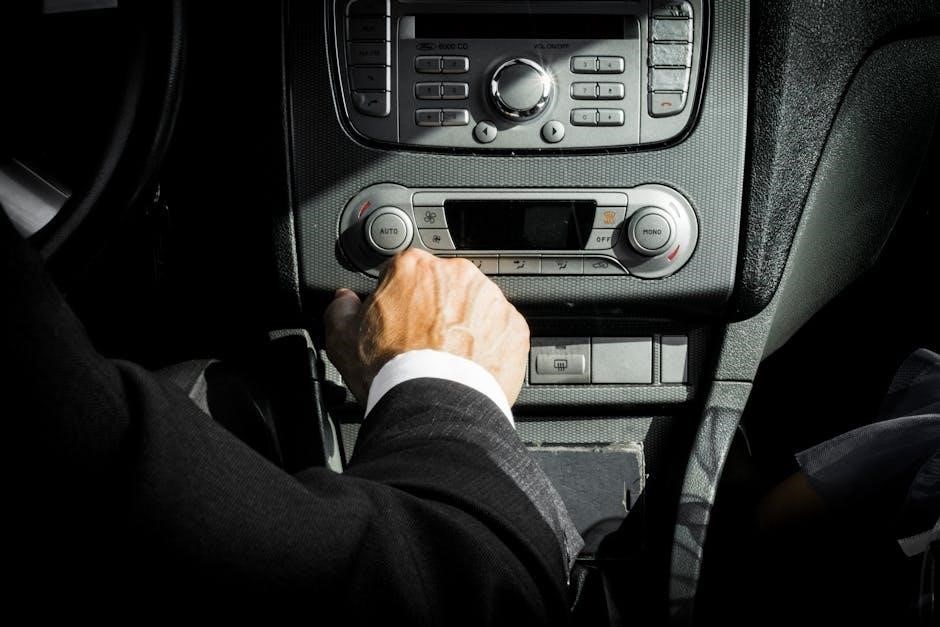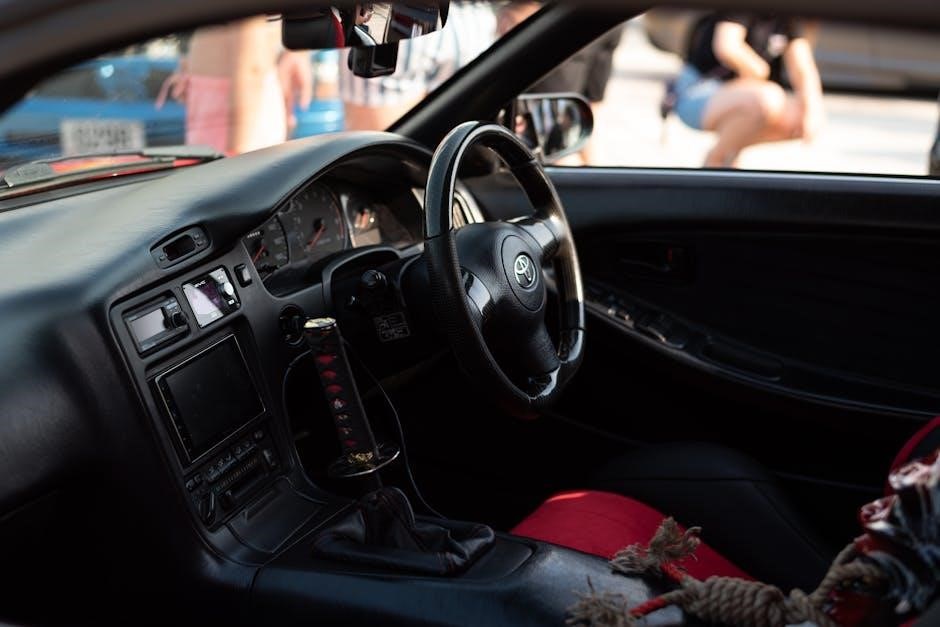The debate between shift paddles and manual transmissions revolves around control, convenience, and driving experience. Paddle shifters offer ease and speed, while manuals provide tactile engagement and precision.
1.1 Overview of the Debate
The debate between shift paddles and manual transmissions centers on driving engagement, control, and practicality. Enthusiasts argue that manuals offer superior tactile feedback and connection, while paddle shifters provide convenience and faster shifting without a clutch. The discussion often reflects personal preferences, driving styles, and the balance between performance and ease of use in modern vehicles.
1.2 Importance of Understanding the Differences
Understanding the distinctions between shift paddles and manual transmissions is crucial for selecting the right system for your needs. Manuals offer precise control and driver engagement, while paddles provide convenience and ease, especially in traffic. This knowledge helps drivers make informed decisions based on their preferences, driving conditions, and performance requirements, enhancing overall satisfaction and driving efficiency.
What Are Shift Paddles?
Shift paddles are controls on the steering wheel that allow manual gear shifts without a clutch pedal. They integrate with automatic transmissions, offering convenience and ease of use.
2.1 Definition and Functionality
Shift paddles are steering wheel-mounted controls that enable manual gear changes in automatic or dual-clutch transmissions. They function by sending electronic signals to the transmission, eliminating the need for a clutch pedal. This setup allows drivers to switch gears without taking their hands off the wheel, blending manual control with the convenience of an automatic system.
2.2 Benefits of Using Paddle Shifters
Paddle shifters provide quick, clutch-free gear changes, enhancing acceleration and responsiveness. They allow drivers to maintain control without removing hands from the wheel, ideal for spirited driving. Paddle shifters are also more forgiving than manuals, reducing the risk of stalling and offering ease of use in traffic, making them a practical choice for everyday driving without sacrificing performance.

What Is a Manual Transmission?
A manual transmission is a gear system requiring driver operation via a clutch pedal and gearshift, offering precise control and a direct connection to the vehicle’s mechanics.
3.1 Mechanics and Driver Involvement
A manual transmission relies on a clutch pedal and gearshift to manually change gears. The driver must press the clutch, select the desired gear, and release the clutch smoothly. This process requires coordination between the clutch, accelerator, and gearshift, creating a direct, tactile connection between the driver and the vehicle’s mechanics. The driver’s active involvement enhances control and engagement, making it a preferred choice for driving enthusiasts seeking precision and a hands-on experience behind the wheel.
3.2 Advantages of Manual Gearboxes
Manual gearboxes offer enhanced driver control, allowing precise gear changes for optimal acceleration and speed management. They provide a more engaging and enjoyable driving experience, fostering a stronger connection between the driver and the vehicle. Additionally, manuals can be more fuel-efficient in certain driving conditions and typically have lower maintenance costs due to their simpler mechanical design compared to automatic or paddle-shift systems.
Key Differences Between Shift Paddles and Manual
Shift paddles offer convenience and ease, while manuals provide greater control and driver engagement. Manuals lack paddle shifters’ automation but deliver a more tactile, immersive driving experience.
4.1 Level of Driver Control
Manual transmissions provide direct control over gear shifts, allowing drivers to make precise changes based on their input. Paddle shifters, while offering manual-like control, rely on the car’s computer for execution, reducing mechanical feedback and driver involvement compared to traditional manuals. This difference significantly impacts the driving experience for enthusiasts seeking heightened engagement.
4.2 Convenience and Ease of Use
Paddle shifters are more convenient, as they eliminate the need for a clutch pedal and allow gear changes without taking hands off the steering wheel. This makes them ideal for stop-and-go traffic and easier to use for new drivers. In contrast, manual transmissions require more skill and physical effort, making them less practical in heavy traffic conditions.
4.3 Driving Style and Preferences
Paddle shifters cater to drivers who value a sporty feel without the complexity of a manual. They’re ideal for racing or spirited driving, where quick shifts are essential. Manual transmissions, however, are favored by purists who enjoy the tactile connection and control, making them perfect for enthusiasts who prioritize driving engagement over convenience.
Performance Comparison
Paddle shifters deliver swift, precise shifts, enhancing acceleration in racing scenarios. Manuals provide direct driver control, optimizing performance through tailored gear changes, making them superior for track driving.
5.1 Speed and Responsiveness
Paddle shifters offer faster and more precise gear changes, ideal for competitive driving, as they eliminate the need to move hands from the steering wheel. Manual transmissions, while engaging, can introduce lag due to clutch and gear lever operation, especially for less experienced drivers. Both systems aim to maximize performance but cater to different driving styles and priorities.
5.2 Precision and Driver Engagement
Paddle shifters deliver precise, instantaneous gear changes, enhancing control during dynamic driving. They allow drivers to keep hands on the wheel, improving focus and responsiveness. In contrast, manual transmissions offer a tactile, engaging experience, with the clutch and gear lever providing a direct connection to the vehicle. Each system excels in different scenarios, catering to varying driver preferences and skill levels.
5.3 Real-World Acceleration and Handling
Paddle shifters excel in delivering quick, seamless acceleration, ideal for sporty driving, while maintaining handling precision. Manual transmissions offer superior mechanical feedback, enhancing control during sharp turns and dynamic maneuvers. Each system shines in specific conditions, with paddle shifters favoring speed and convenience, and manuals emphasizing driver connection and responsiveness behind the wheel.

Driver Engagement and Emotional Connection
Manual transmissions foster a deeper emotional connection through tactile feedback and mechanical involvement, while paddle shifters prioritize convenience and speed, catering to distinct driving preferences and styles.
6.1 The Joy of Manual Shifting
Manual shifting creates a direct link between driver and vehicle, offering tactile feedback and a sense of control. The clutch and gear lever engage the driver physically and mentally, making every shift deliberate and satisfying. This connection enhances the driving experience, turning routine commutes into engaging adventures for enthusiasts who value precision and involvement.
6.2 Paddle Shifters and Sporty Driving
Paddle shifters enhance sporty driving by allowing rapid gear changes without removing hands from the wheel. This feature is particularly beneficial for racing or dynamic driving, where quick reflexes and control are crucial. Paddle shifters provide a balance of convenience and engagement, making them appealing for drivers who seek both performance and ease of use in spirited driving scenarios.

Practicality and Daily Driving
Paddle shifters offer convenience in traffic, while manuals suit experienced drivers. Both cater to different needs, balancing ease of use and driver preference in daily commuting.
7.1 Traffic and City Driving
In heavy traffic, paddle shifters simplify driving by eliminating clutch usage, reducing fatigue. Manuals require constant gear changes, which can be tiring in stop-and-go conditions. Paddle shifters provide a smoother, more relaxed experience, making them ideal for urban environments where frequent stopping is unavoidable.
7.2 Ease of Use for New Drivers
Paddle shifters are more user-friendly for new drivers, as they eliminate the need for a clutch pedal and manual gear coordination, simplifying the learning process. Manual transmissions require practice to master, with coordination between the clutch and accelerator, which can be challenging for inexperienced drivers. Paddle shifters reduce complexity, making them a better option for those learning to drive.
7.3 Maintenance and Reliability
Manual transmissions are often more reliable and require less maintenance than paddle-shift systems, as they have fewer complex components. Paddle shifters, tied to automatic or dual-clutch transmissions, involve more advanced technology, which can lead to higher repair costs and complexity. Manuals generally have longer lifespans with proper care, while paddle systems rely on sophisticated electronics that may need specialized attention.

Cost Considerations
Manual transmissions are typically more affordable upfront and long-term, while paddle-shift systems, with their advanced technology, often come with higher initial and maintenance costs over time.
8.1 Upfront Costs
Manual transmissions are generally more cost-effective to purchase upfront, as they are simpler in design. Paddle-shift systems, featuring advanced electronics and components, are typically more expensive initially, reflecting their sophisticated technology and manufacturing complexity. This upfront cost difference is significant for budget-conscious buyers, making manual transmissions a more accessible option for many drivers.
8.2 Long-Term Maintenance Expenses
Manual transmissions often incur lower long-term maintenance costs due to their simpler mechanical design. In contrast, paddle-shift systems, with their electronic components and complex engineering, can be more expensive to repair and maintain over time; This makes manual transmissions a more economical choice for drivers prioritizing long-term affordability and reliability.

Future Trends and Technology
Shift paddles and manual transmissions are evolving with advancements in automotive technology. Paddle shifters are integrating smarter electronics for faster, more precise shifting, while manuals are adopting hybrid and semi-automatic features to blend tradition with innovation, ensuring both systems remain relevant in the era of autonomous and electric vehicles.
9.1 Advancements in Paddle Shifters
Modern paddle shifters are evolving with advanced electronics, offering faster response times and seamless control. They now integrate with adaptive transmission systems, optimizing gear shifts based on driving conditions. Enhanced software enables predictive shifting, reducing lag and improving acceleration. These advancements make paddle shifters more efficient and driver-friendly, blending performance with convenience for a superior driving experience.
9.2 The Evolution of Manual Transmissions
Manual transmissions have seen significant improvements, with modern designs offering smoother gear engagement and reduced driver fatigue. Lightweight materials and optimized gearing enhance performance and fuel efficiency. Rev-matching technology and automated manual systems are emerging, blending traditional control with modern convenience. These advancements ensure manuals remain relevant, appealing to purists while adapting to contemporary driving demands and preferences;
9.3 Emerging Technologies in Transmission Systems
Next-gen transmission systems are blending paddle shifters and manual tech with hybrid and dual-clutch innovations. Automated manual systems and AI-driven shift logic are becoming standard, enhancing both performance and efficiency. These advancements promise seamless gear changes, reduced latency, and personalized driving experiences, ensuring transmissions adapt to evolving driver needs and electrification trends in the automotive industry.
The debate between shift paddles and manual transmissions ultimately hinges on personal preference, driving style, and priorities. Both options offer unique benefits, catering to different needs and experiences.
10.1 Summary of Key Points
The comparison between paddle shifters and manual transmissions highlights differences in driver control, convenience, and emotional engagement. Paddle shifters offer ease and speed, ideal for racing and sporty driving, while manuals provide tactile feedback and precision, appealing to purists. Practicality, cost, and personal preference are key factors. Both options cater to distinct needs, making the choice subjective.
10.2 Final Thoughts and Recommendations
Choose paddle shifters for convenience and speed, especially in racing or sporty driving. Opt for manual transmissions if you value tactile engagement and precision. Consider your lifestyle, driving habits, and preferences. Both options excel in their domains, so select the one that aligns with your needs for an optimal driving experience.